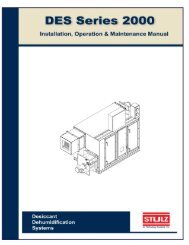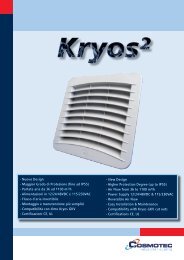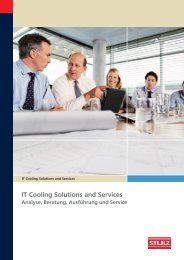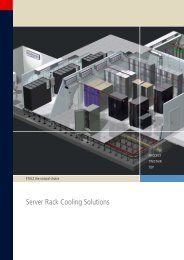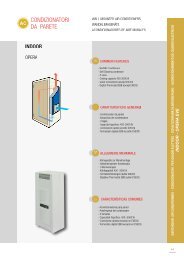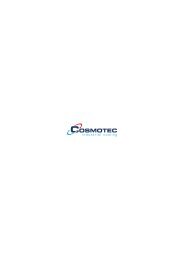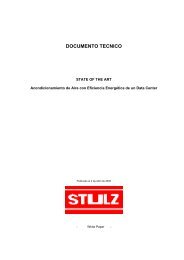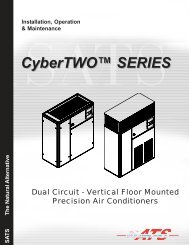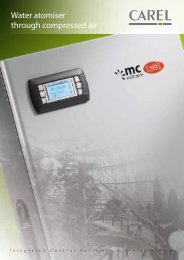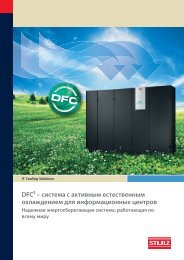Mini-Space Series Installation, Operation & Maintenance Manual
Mini-Space Series Installation, Operation & Maintenance Manual
Mini-Space Series Installation, Operation & Maintenance Manual
You also want an ePaper? Increase the reach of your titles
YUMPU automatically turns print PDFs into web optimized ePapers that Google loves.
<strong>Mini</strong>-<strong>Space</strong> <strong>Series</strong> <strong>Installation</strong>, <strong>Operation</strong> & <strong>Maintenance</strong> <strong>Manual</strong>factory installed in the outdoor condenser/condensingunit. The fan speed controller requires no adjustment.The fan speed controller will automatically control thehead pressure. On systems with more than one fanon the condenser, the remaining motors cycle on andoff based on pressure.2.10.2.4 Intelligent Control(Condenser Model SCS-EC only, -20°F)Used for outdoor installations where ambient condenserair inlet temperatures may fall to -20°F, intelligentpressure control is designed to maintain dischargepressure by constantly modulating condenserfan speed. SCS outdoor condensers are equippedwith highly efficient, electronically commutated (EC),axial fan(s). The EC fan speed is infinitely variableup to full speed. The control system utilizes refrigerantpressure transducer(s) to monitor refrigerantdischarge pressure and control the EC fan(s) to theprecise speed needed to maintain design refrigerantdischarge pressures.2.10.2.5 Flooded Head Pressure Control(Condenser Model SCS-AA with FanCycling, -30°F)Used for outdoor installations where ambient condenserair inlet temperatures may fall to -30°F, fl oodedhead pressure control is designed to maintainhead pressure during low ambient conditions. A headpressure control valve and a receiver are used in therefrigeration circuit to back up liquid refrigerant intothe condenser coil. The head pressure control valveis a 3-way modulating valve controlled by dischargepressure.When the A/C unit begins to operate, the dischargepressure rises to 275 psig and the condenser fan iscycled on, as described in Section 2.10.2.1. Whenambient temperature drops, the discharge pressuredrops also. When the discharge pressure drops toapproximately 180 psig, the head pressure controlvalve diverts discharge gas away from the condenserto the receiver. Liquid flow from the condenser isrestricted, causing liquid to back up in the condenser.Flooding the condenser reduces the area availablefor heat transfer. The desired result is to increase thepressure into the condenser, maintaining a minimumdischarge pressure during low ambient operationthus ensuring proper condensing temperature. Thehead pressure control valve requires no adjustment.This method of controlling head pressure allows thecondenser fan to run continuously. While the fan isrunning, the fl ooded head pressure control valvemodulates the amount of discharge gas entering thereceiver. As the pressure increases, the valve divertsmore discharge gas to the condenser, allowing moreliquid to fl ow from the condenser to the receiver.When using this method of head pressure regulationthere must be enough refrigerant in the system to ensureadequate charge at the lowest expected ambienttemperature in which the system will be operating. Areceiver is used to store the extra refrigerant when thecondenser is not using it.NOTESystems utilizing air cooled condensers must nothave a refrigerant line pressure drop over 14 psigacross the condenser and the interconnectingpiping to the condenser sections.2.10.2.6 Flooded Head Pressure Control(Condenser Model HES-CAA , 30°F)Used for indoor installations where ambient condenserair inlet temperatures may fall to -30°F. First, familiarizeyourself with Flooded Head Pressure Control asdiscussed in Section 2.10.2.5. Instead of cycling thefan on and off, the condenser fan speed is continuous.The head pressure control valve diverts discharge gasto the receiver causing liquid to back up in the condenser,as described in Section 2.10.2.5, while the fancontinues to run.2.10.3 Head Pressure Controls-Water/Glycol Cooled SystemsIn a water/glycol condenser, condensing temperatureis maintained by the liquid fl owing through a regulatingvalve and then into a liquid-cooled condenser. Theregulating valve opens to increase the liquid fl ow asthe refrigerant pressure rises (or closes as the refrigerantpressure falls). The regulating valve is factory setfor the correct condensing temperature however, it canbe adjusted to increase or decrease the condensingtemperature.Head pressure regulating valves are available in 2-wayor 3-way configurations. Refer to the piping diagram to(©April, 2008)2-18Air Technology Systems, Inc.



